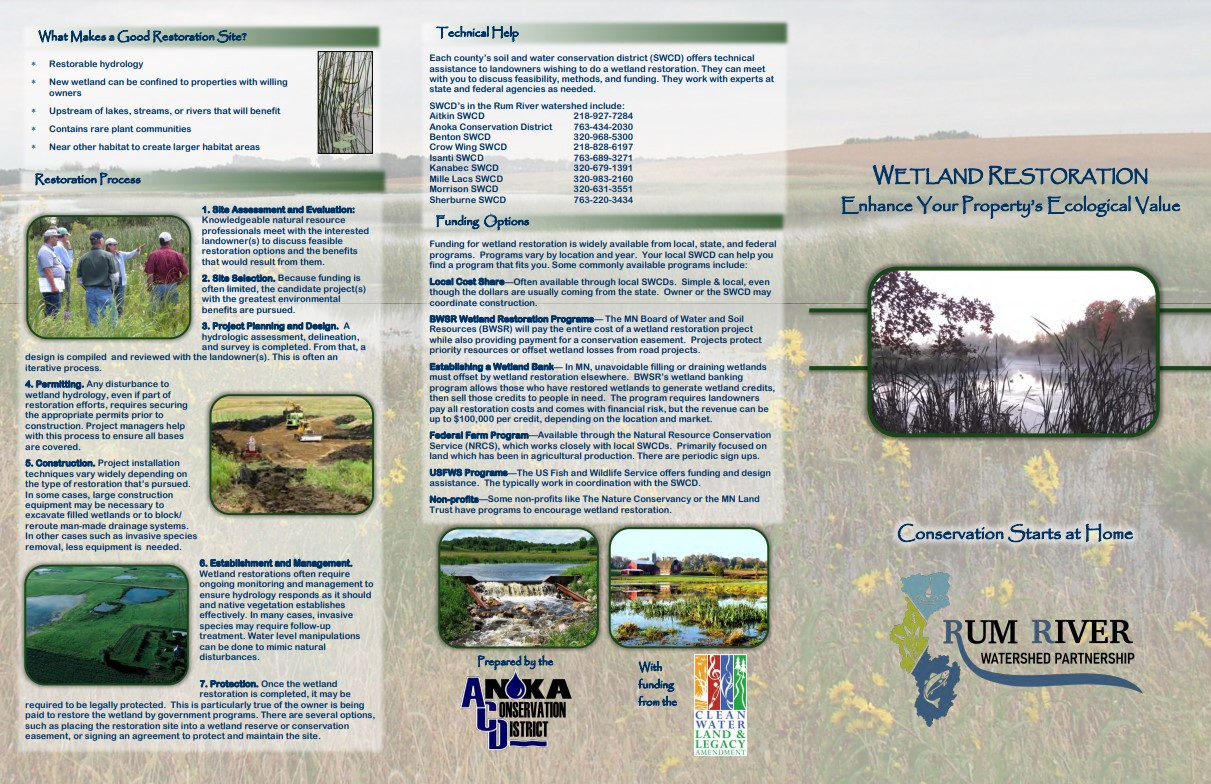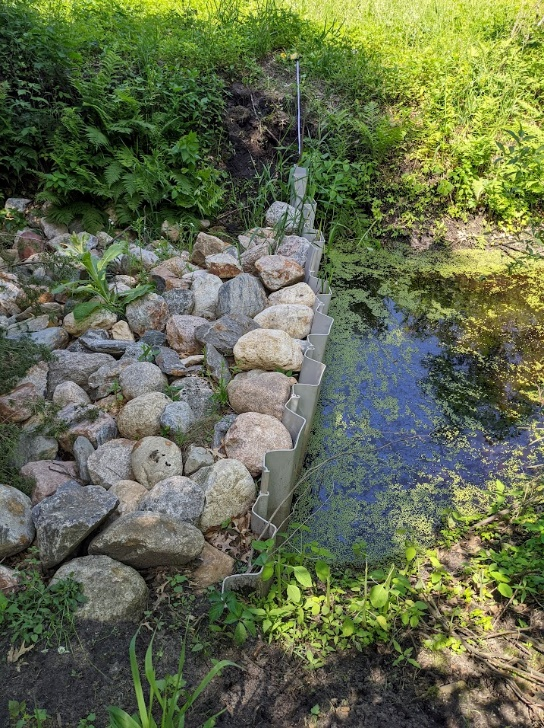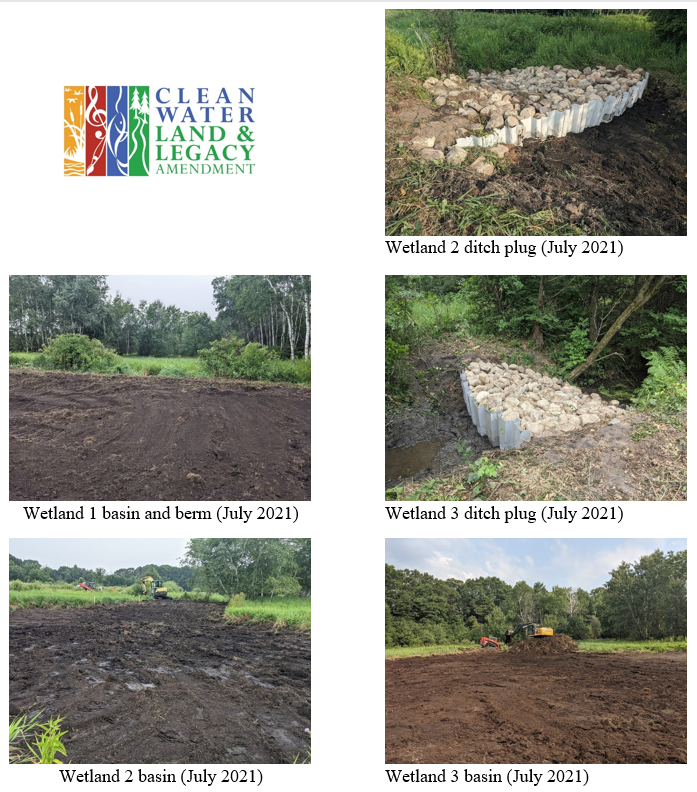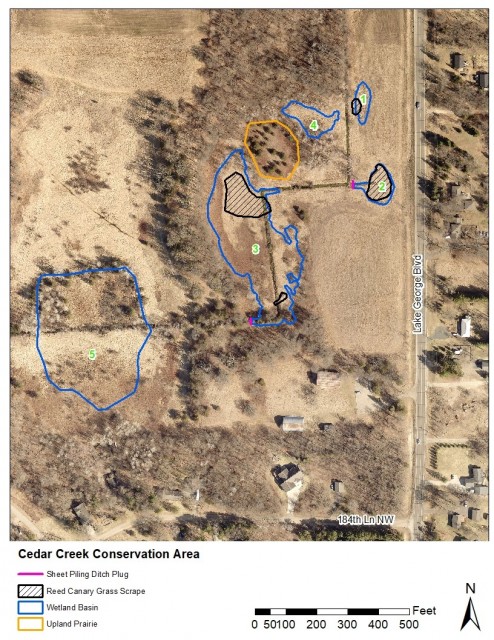Two local lakes and the Sunrise River will benefit from an upcoming wetland restoration project. ACD has secured a $221,375 Clean Water Fund grant, from the Clean Water, Land and Legacy Amendment. The new wetland will receive water from Ditch 20 to remove phosphorus. That nutrient is responsible for "impaired" conditions, including excessive algae blooms, in downstream waters. The project is immediately upstream of Typo Lake, which in turn drains to Martin Lake and the West Branch of the Sunrise River. Construction is anticipated in 2026. For more information contact Jamie Schurbon, Watershed Projects Manager, at
ACD is collaborating with Anoka County Parks to enhance wetland basins in the Cedar Creek Conservation Area. Efforts are underway to increase plant diversity and to shift the wetland plant communities to sedge meadow and wet meadow. Both basins were initially dominated by reed canary grass. In 2021, two sheet pile plugs were installed in the ditch system and reed canary grass scrapes occurred in the east side basin (see map below). Native plants emerged where reed canary grass was scraped away. Management including mowing, spot herbicide treatment and seeding continue in this area to increase plant diversity.
The upland – wetland basin in the CCCA has the potential to be restored to native dry prairie and sedge meadow habitats. Many of the remaining sedge meadows are often only fragmented narrow strips, adjacent to non-native cattails, making them difficult to manage. It is feasible to create a burn break around this unique wet meadow and prairie habitat to restore and maintain the plant communities. There is an opportunity to include this area with an adjacent dry prairie that is part of a regularly scheduled prescribed burn management plan. Additionally, the soil type along the wetland margin in this basin are known to support rare plant species. Once restored, this site could be a recipient site for rescued rare plants. For more information contact Carrie Taylor,Restoration Ecologist, at
The ditch plugs and berms at Cedar Creek Conservation Area are retaining this year's rainfall in the wetland basins, keeping the water on the landscape instead of channeling it to Cedar Creek and the Rum River during larger rain events. The organic wetland soils are saturated instead of dried out and vegetation is shifting to a native plant community to provide habitat for wildlife. These late summer photos below show native plants and standing water in an area that was previously drained and dominated by reed canary grass. ACD staff continue to control reed canary grass in some areas and spread native seed as needed. See 2021 Construction photos here.
For more information contact Carrie Taylor, Restoration Ecologist, at
Minnesota is rich in wetlands which provide numerous benefits such as flood mitigation, groundwater recharge, water quality improvement, recreation, and high-quality habitat for a wide variety of fish and wildlife species. However, many wetlands exist in a degraded state due to decades of human disturbances such as drainage and filling to increase usable land for agriculture and urban development.
Recognizing their importance, many federal, state, and local agencies have developed programs to provide technical expertise and funding for wetland restoration projects. The goal of wetland restoration is to return a wetland to its natural functions, and the nature of each project depends on the wetland's unique location, hydrology, soils, vegetation, and impacts (historic and current).
Restoring wetlands on your property adds to its ecological value and can often be financially beneficial. Understanding your options can be complicated, which is why ACD – on behalf of, and with funding from, the Rum River Watershed Partnership – created a new wetland restoration brochure. In it, you will find information on benefits, approaches, processes, and funding options common for wetland restoration projects. Click here to access the brochure below.
Anoka County Residents: ACD currently has funding to support wetland restorations benefitting the Rum River! If you live near the Rum River, believe that you have impacted wetlands on your property, and are interested in restoring them, please contact Breanna Keith, Water Resources Technician, at
Anoka County is rich in wetlands that provide countless benefits to the county's ecological and water resources. Wetlands capture and filter floodwater and runoff, provide habitat for aquatic and terrestrial species, and help recharge the groundwater supply. Anoka County has lost approximately half of its original wetlands since European settlement. Historically wetlands have been drained and filled to create more useable land for agriculture and rural development. Many regulations exist to protect wetlands today, but a history of impacts combined with present-day challenges such as invasive vegetation, increasing demands for housing and suburban development, and altered hydrology threaten what remains.
For these reasons, the Anoka Conservation District (ACD) has increased efforts to identify wetland protection and restoration opportunities. An inventory of restorable wetlands was recently completed for two priority watersheds in the county including the Ford Brook watershed and the Rum River direct drainage watershed. Altogether, approximately 70 potential wetland restoration sites were identified across both private and public lands. In the coming months, ACD will conduct outreach and explore these possible opportunities in more depth, with the goal of restoring hydrology and native vegetation at one or more sites in 2024.
ACD has enhanced wetland habitat via vegetation management for several years, but hydrologic restorations are a relatively new endeavor which require careful planning, holistic approaches, and multi-agency collaboration. In 2022, five acres' worth of wetlands on public land were successfully restored by plugging drainage ditches which restored previous hydrology conditions and managed current vegetation such as the invasive reed canary grass to improve habitat with a diversity of native species.
For more information contact Brenna Keith,
The Anoka Conservation District, US Fish and Wildlife Service, and Anoka County Parks are collaborating to restore hydrology and enhance five acres of wetland and one acre of upland prairie at Anoka County Park's Cedar Creek Conservation Area. Two wetland basins were enhanced by installing sheet piling ditch plugs and adding fill material in a private ditch that was draining the wetlands. A berm to prevent water from entering the ditch was constructed to enhance a third wetland basin. Non-native reed canary grass biomass and root sod was scraped from these wetland basins and used to fill the ditch. Construction is complete and vegetation management will occur on these three basins and two additional basins in the area for the next five years using funds from the Lessard-Sams Outdoor Heritage Council. The goal is to convert these once drained wetlands that were dominated by reed canary grass to wetlands with native vegetation and greater water holding capacity. This will provide benefits to water quality and improve wildlife habitat.
The Minnesota Board of Water and Soil Resources (BWSR) is seeking to restore previously drained or filled wetlands and adjacent uplands to develop wetland credits for the Local Government Road Wetland Replacement Program (LGRWRP). This program provides wetland mitigation for qualifying road construction, repair, and rehabilitation projects conducted by local road authorities such as cities, townships, and counties.
Opportunities are available for landowners and local government entities in throughout the state including Anoka County.
Restoration opportunities include:
- BWSR easement signup which operates the same as Reinvest In Minnesota (RIM) and Conservation Reserve Enhancement Program (CREP)
- Credit development and sale to BWSR through a third party
- Credit development in partnership with BWSR
The difficult part of this program was that BWSR wanted projects that were relatively far along in the process since wetland banking starting from scratch is a 4 to 5 year endeavor for the first credits to be established. The funds they were using had a 3 year deadline for completion.
At first, we did not think we had any projects far enough along, but then I reached out to a landowner in Oak Grove who had a significant portion of his proposal completed so we are hoping that this is a good fit for the BWSR program. This project north of 221st Ave NW would restore over 60 acres of wetland that have been drained for decades for farming. It is in the headwaters of Lake George.













